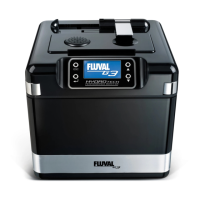HYDRO TECH PERFORMANCE MONITOR
ADVANCED FILTRATION SYSTEM
www.fluval-g.com
EN.24
FLUVAL G ELECTRICAL CONDUCTIVITY (EC) MONITORING SYSTEM
What is Electrical Conductivity?
Electrical conductivity (EC) is a measure of the water’s ability to “carry” an electrical current and indirectly, a
measure of dissolved solids or ions in the water. Pure water has a very low conductivity value (nearly zero);
hence, the more dissolved solids and ions occurring in the water, the more electrical current the water is
able to conduct.
How does the Fluval G EC Monitoring System measure the Electrical Conductivity in my aquarium?
The Fluval G instrumentation senses water through a special conductivity probe consisting of two titanium
alloy terminals, which will not age or degrade through oxidation and ageing. The conductivity probe in
conjunction with the temperature sensor measures the electrical resistance of aquarium water. The
sophisticated software then interprets the electrical signal to calculate and display the conductivity value.
The system recognizes if the aquarium contains fresh water or salt water, and automatically displays the
correct value in either (microsiemens) μS/cm for fresh water or (millisiemens) mS/cm for marine tanks).
The system constantly monitors aquarium conductivity and also provides a rolling line graph, which records
the historical daily readings (1 reading every 12 hours), covering up to 48 days of historical data. You also
have the ability to set an alarm to show the maximum and minimum settings.
Note:
For a correct reading of
the conductivity value at
the filter’s 1st startup
or after maintenance
operations, it is
recommended to let the
unit operate for at least
48 hours so any air
bubbles trapped in the
filter can be released.
Otherwise, the probe’s
accuracy will be
reduced.
It’s important to note that conductivity is a gross measurement only, and cannot specifically indicate the
concentration or presence of any one specific component.
The EC Monitoring system is also used to protect the aquarium against other abnormal operation conditions,
such as the absence of water within the filter.
Why is Electrical Conductivity so important in aquaria?
One of the most important issues for aquarium keepers is providing and maintaining a suitable and stable
environment for living organisms; EC plays an important role in monitoring both fresh and saltwater tanks,
providing a general, but fundamental alert that something is changing inside the aquarium.
It is something similar to the body temperature of a person: a deviation from the “normal” range does not
point to a specific illness, but suggests that something is changing or has been altered, and needs to be
investigated.
In nature, every biotope can be identified by a complex list of interrelated characteristics. In aquatic
environments, EC is a very important element. Fish are very sensitive to this value since conductivity is
strictly related to the amount of osmotic pressure exerted on their cellular membranes. While they are well
adapted to the specific conductivity range of the environment in which they live, you still have to ensure the
fish you are placing into your aquarium are suitable to the water. If the water is not the right environment
for them, your fish will need to continuously pump water in or out, so that the osmotic pressure is equalized
across their cell membranes.
RETURN TO CONTENTS PAGE
CONDUCTIVITY SENSOR G3 G6
Type
Material of the electrodes Titanium Titanium
Measurement range in fresh water μS/cm from 10 - 2000 from 10 - 2000
Instrument accuracy in fresh water
from 100 to 1500 us.cm
% +/
_
3% +/
_
3%
Measurement range in salt water mS/cm from 20 - 80 from 20 - 80
Instrument accuracy in salt water
from40to80mS/cm % +/
_
4% +/
_
4%
Contact type,
Volt/Ampermetric
measuring
Contact type,
Volt/Ampermetric
measuring

